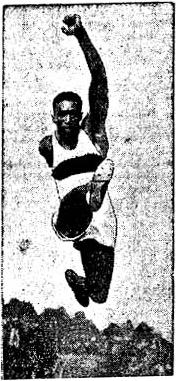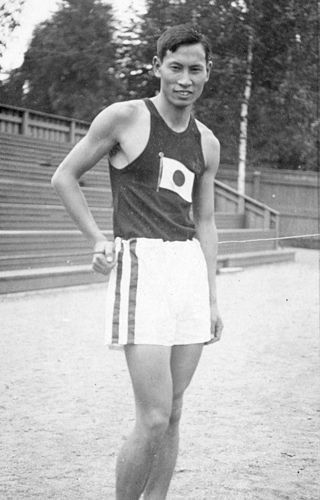
Mikio Oda was a Japanese athlete and the first Japanese Olympic gold medalist. He was the first Asian Olympic champion in an individual event.

Vilho "Ville" Immanuel Tuulos was a Finnish triple jumper and long jumper, who won a gold medal at the 1920 Summer Olympics in Antwerp.

Finland competed at the 1920 Summer Olympics in Antwerp, Belgium for the first time as a fully independent state. It competed independently in 1908 and 1912 as the autonomous Grand Duchy of Finland within the Russian Empire. 63 competitors, 62 men and 1 woman, took part in 51 events in 9 sports.

The men's triple jump, also known as the hop, step, and jump, was a track and field athletics event held as part of the Athletics at the 1912 Summer Olympics programme. The competition was held on Monday, July 15, 1912. Twenty athletes from eight nations competed. NOCs could enter up to 12 athletes. The event was won by Gustaf Lindblom of Sweden, the nation's first medal in the men's triple jump. Georg Åberg and Erik Almlöf also medaled for Sweden, completing a sweep—previously accomplished twice by the United States in 1900 and 1904.

The men's triple jump event was part of the track and field athletics programme at the 1920 Summer Olympics. The competition was held from Thursday, August 19, 1920, to Saturday, August 21, 1920. Twenty-one triple jumpers from eight nations competed. No nation had more than four jumpers, suggesting the limit had been reduced from the 12 maximum in force in 1908 and 1912. The event was won by Vilho Tuulos of Finland, the nation's first medal in the triple jump. Sweden, which had swept the medals in 1912, took the next three places. Erik Almlöf became the third man to win two medals in the event, repeating his bronze performance from 1912.
The men's triple jump event at the 1980 Summer Olympics in Moscow, Soviet Union had an entry list of 23 competitors, with two qualifying groups before the final (12) took place on Friday, July 25, 1980. The maximum number of athletes per nation had been set at 3 since the 1930 Olympic Congress. The top twelve and ties, and all those reaching 16.55 metres advanced to the final. The qualification round was held on Thursday, July 24, 1980.
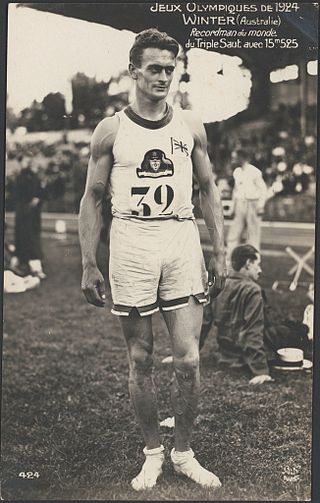
The men's triple jump event was part of the track and field athletics programme at the 1924 Summer Olympics. The competition was held on Saturday, July 12, 1924. Twenty triple jumpers from twelve nations competed. The maximum number of athletes per nation was 4. The event was won by Nick Winter of Australia, the nation winning gold in its debut in the event. Argentina also medaled in its first triple jump appearance, with Luis Brunetto taking silver. Defending champion Vilho Tuulos of Finland took bronze, the fourth man to win a second medal in the event.
The men's triple jump event at the 2000 Summer Olympics as part of the athletics program was held at the Olympic Stadium. Forty athletes from 27 nations competed. The maximum number of athletes per nation had been set at 3 since the 1930 Olympic Congress. The triple jump has been ever present since the beginning of the modern Olympic Games in 1896. The event was won by Jonathan Edwards of Great Britain, the nation's first victory in the men's triple jump since 1908. Edwards became the 12th man to win two medals in the event, adding gold to his 1996 silver. Yoel García's silver put Cuba on the podium for the second Games in a row.

The men's triple jump at the 1952 Olympic Games took place on 23 July at the Helsinki Olympic Stadium. Thirty-five athletes from 23 nations competed. The maximum number of athletes per nation had been set at 3 since the 1930 Olympic Congress. Brazilian athlete Adhemar da Silva won the gold medal, breaking the world record twice. It was Brazil's first medal and first victory in the men's long jump. All three of the nations represented on the podium were relatively new to the event in the Olympics; Brazil had sent triple jumpers in 1948, but the Soviet Union and Venezuela each won medals in their first appearance.

The men's long jump event was part of the track and field athletics programme at the 1928 Summer Olympics. The competition was held on Tuesday, July 31, 1928. Forty-one long jumpers from 23 nations competed. The maximum number of athletes per nation was 4. The event was won by Ed Hamm of the United States, the nation's second consecutive and seventh overall victory in the event. Silvio Cator earned Haiti's first medal in the event by taking silver.

The men's high jump event at the 2000 Summer Olympics as part of the athletics program was held at the Olympic Stadium on Friday, 22 September and Sunday, 24 September. Thirty-five athletes from 24 nations competed. The maximum number of athletes per nation had been set at 3 since the 1930 Olympic Congress. The high jump has been ever present since the beginning of the modern Olympic Games in 1896. The event was won by Sergey Klyugin of Russia, the nation's first medal and victory in the men's high jump in the nation's first appearance after the breakup of the Soviet Union. Javier Sotomayor of Cuba was the eighth man to win a second medal in the event ; he joined Valeriy Brumel and Jacek Wszoła as the most successful Olympic high jumpers in history with a gold and a silver—despite missing the 1984 and 1988 Games due to boycott and being hampered by injury in 1996. Abderrahmane Hammad's bronze was Algeria's first medal in the men's high jump.

The men's high jump event at the 1928 Olympic Games took place July 29. Thirty-five athletes from 17 nations competed. The maximum number of athletes per nation was 4. Bob King won the final with a jump of 1.94 metres. Four other competitors cleared 1.91 metres, and their placement was decided via a jump-off. King's victory was the United States' eighth consecutive victory in the men's high jump; Benjamin Hedges's silver made it the third straight Games in which Americans went 1–2. Claude Ménard earned France's second consecutive bronze medal in the event.

The men's triple jump event at the 1932 Olympic Games took place August 4. Sixteen athletes from 12 nations competed. The 1930 Olympic Congress in Berlin had reduced the limit from 4 athletes per NOC to 3 athletes. Chūhei Nambu of Japan won gold with a world record breaking jump. It was Japan's second consecutive gold medal in the men's triple jump; Japan also became the third nation to have two medalists in the event in the same Games as Kenkichi Oshima took bronze. Sweden took its first medal in the event since 1920 with Erik Svensson's silver.
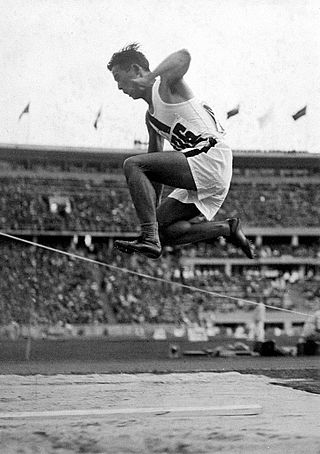
The men's triple jump event was part of the track and field athletics programme at the 1936 Summer Olympics. The competition was held on August 6, 1936. Thirty-one athletes from 19 nations competed. The maximum number of athletes per nation had been set at 3 since the 1930 Olympic Congress. The final was won by Naoto Tajima of Japan with a world-record jump. It was Japan's third consecutive gold medal in the men's triple jump; as of the 2016 Games, it is the last gold medal Japan has won in the event. Masao Harada's silver medal made it the second Games in which Japan put two men on the podium in the event. Jack Metcalfe of Australia earned bronze, Australia's first medal in the event since 1924.

The men's triple jump field event at the 1960 Olympic Games took place on September 6. Thirty-nine athletes from 24 nations competed. The maximum number of athletes per nation had been set at 3 since the 1930 Olympic Congress. Józef Szmidt of Poland won the gold medal. It was Poland's first medal and first victory in the men's triple jump. Vitold Kreyer of the Soviet Union repeated his bronze medal performance from 1956, becoming the sixth man to win two medals in the event. His countryman Vladimir Goryaev took silver; this made the Soviet Union the fourth nation to have two men on the podium in the same year in the triple jump and the fourth nation to reach the podium three Games in a row.
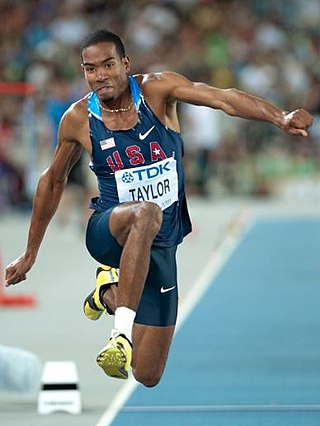
The men's triple jump competition at the 2012 Summer Olympics in London, United Kingdom. The event was held at the Olympic Stadium on 7–9 August. Twenty-seven athletes from 21 nations competed. The event was won by Christian Taylor of the United States, the nation's first victory in the event since 1996 and seventh overall. His teammate Will Claye won silver; Claye was the first man to medal in both the long jump and triple jump since 1936. Fabrizio Donato earned Italy's first medal in the men's triple jump since 1968.

The men's triple jump event at the 1976 Summer Olympics in Montreal, Quebec, Canada, had an entry list of 25 competitors, with two qualifying groups before the final (12) took place on Friday July 30, 1976. The top twelve and ties, and all those reaching 16.30 metres advanced to the final. The qualification round was held in Thursday July 29, 1976. The maximum number of athletes per nation had been set at 3 since the 1930 Olympic Congress.

The men's triple jump event at the 1972 Summer Olympics in Munich was held on 3 & 4 of September. Thirty-six athletes from 28 nations competed. The maximum number of athletes per nation had been set at 3 since the 1930 Olympic Congress. The event was won by Viktor Saneyev of the Soviet Union, the fourth man to repeat as Olympic champion in the triple jump. The Soviets were on the podium in the event for the sixth consecutive Games. Jörg Drehmel of East Germany won the first men's triple jump medal by any German jumper. Nelson Prudêncio of Brazil was the ninth man to win a second medal in the event, following up his 1968 silver with bronze in Munich.

The triple jump at the Summer Olympics is grouped among the four track and field jumping events held at the multi-sport event. The men's triple jump has been present on the Olympic athletics programme since the first Summer Olympics in 1896. The women's triple jump is one of the more recent additions to the programme, having been first contested in 1996. It became the third Olympic jumping event for women after the high jump and long jump.

The men's triple jump competition at the 2016 Summer Olympics in Rio de Janeiro, Brazil. The event was held at the Olympic Stadium on 15–16 August. Forty-seven athletes from 35 nations competed. The event was won by Christian Taylor of the United States, the fifth man to successfully defend Olympic gold in the triple jump. It was the United States' eighth victory in the event. Just as in London four years earlier, Will Claye took silver; the two Americans were the 13th and 14th men to win multiple medals in the event. Dong Bin of China earned bronze, the nation's first medal in the men's triple jump.
